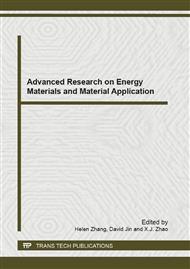[1]
William K Y. Farm-level models of spatial patterns of land use and land cover dynamics in the Ecuadorian Amazon[J], Agriculture Ecosystems and Environment, 2004, 101(2-3): 117-134.
DOI: 10.1016/j.agee.2003.09.022
Google Scholar
[2]
Zhou Sheng-lu, Zhu Qing, Zhao Qiguo. Variation of Land Use Structure in Nanjing Over the Last Decade[J]. Soils, 2005, 37(4): 394-399.
Google Scholar
[3]
Zhang Liping, Zhang Ruibo. Research on the Land Use Components Developing Change in the Urbanization Processes of Hangzhou[J]. Economic Geography, 2004, 24(6): 793-796.
Google Scholar
[4]
Hu Xianhui, Zhang Xia, Yang Gangqiao. Analysis on the Change of Land Use Structure and Its Driving Force in Hubei Province[J]. Resources and Environment in the Yangtze Basin, 2008, 17(1): 43-46.
Google Scholar
[5]
Churiecc E. Intergration of linear of programming an GIS for land use modelling[M]. Intemat-Ional Journal of Geographical Information System, 1994, (3): 204.
Google Scholar
[6]
Dong Nan, Tao Junde. Analysis on land use structure using Lorenz curve and Gini coefficient - a case study of Hegang City, Heilongjiang Province [J]. Land and Resources Information, 2009, (6) : 38-42, 48.
Google Scholar
[7]
Cai Fei, Jin Hong. The Judgment of the Resource-based Regions in China with the Theory on Location Entropy[J]. Technoeconomics & Management Research, 2010, (2): 142-144.
Google Scholar
[8]
Huamg Yufeng, XU Changming, Huang Yujie. Using Lorenz Curve to Analyze Land Use in Jiangxi Province. Journal of Jiangxi Normal University[J], 2003, 27(2): 177-180.
Google Scholar
[9]
Li Yanfang, Tao Junde, Guan Guofeng. Analysis on Lorenz Curve in Space and Gini's Coefficient of Land Use—aking Harbin as an Example[J]. Study on Technical Economy, 2009, 22(6): 39-42.
Google Scholar
[10]
Ma Huiling. Gini coefficient and its calculation method [J]. Contemporary Tourism: Academic, 2010, (5) : 34-36.
Google Scholar
[11]
He Manxi. A way to calculate the Gini coefficient [J]. Statistics and Decision, 2005, (10) : 128-129.
Google Scholar
[12]
Shi Weiguo. A simple method of calculation of the Gini coefficient [J]. Jiangsu Statistics, 1997, (2) 16 -18.
Google Scholar


